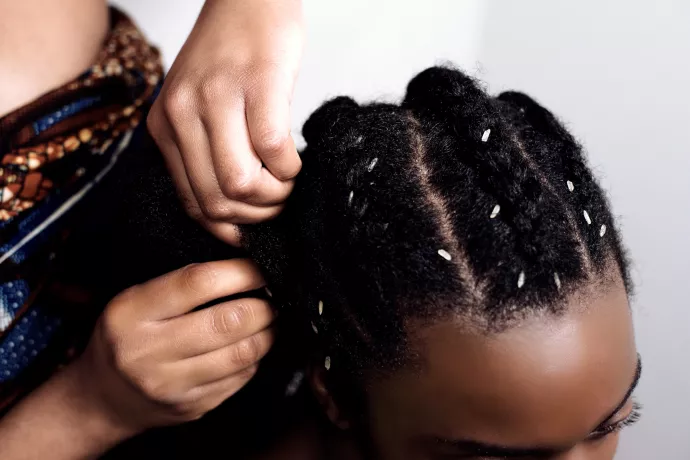
Blackwood Gallery exhibition highlights powerful history behind African hairstyle
Originating in ancient Africa and known today by a name that suggests their colonial history, cornrows are a style of braiding hair close to the scalp in ways that are said to resemble the linear patterns of farm crops.
Beginning next month with an art exhibition installed throughout campus, University of Toronto Mississauga community members will have the opportunity to learn what a powerful history the hairstyle holds.
“For Black cultures, hair has always told a story,” says Inyang Essien, a Nigerian-American artist based in Dallas who will have four photographs featured on UTM’s outdoor lightboxes. They show grains of polished rice — and in one instance, corn — being braided into women’s hair. The action has its roots in a difficult history and represents a deep sense of culture, knowledge and resilience for many.

The artist explains that in preparation for their journey aboard slave ships, kidnapped Africanwomen secreted rice as well as other grains and seeds with them by hiding the items inside their braids. On the other side of the Atlantic, the enslaved kept subsistence gardens — which did not go unnoticed by plantation owners, who saw in the rice a lucrative crop. Its success in the region establishing it as a staple of “Southern cuisine.”
The tactic was revisited by the Maroons of Suriname, who hid grains inside their braids to sustain themselves and their communities while fleeing into the rainforests to escape their enslavers. As noted in the Blackwood program, some varieties of rice still bear the names of the women — like Sééi, Sapali and Tjowa — who carried them to freedom.
“The secret held by their hair was powerful enough to determine life or death,” the artist says.
Essien’s photographs will be the first in a three-part lightbox exhibition, on view through Sept. 2, called Overseeding: Botany, Cultural Knowledge and Attribution. The exhibition is the project of Toronto-based curator Su-Ying Lee, who earned her bachelor degree in art and art history at UTM and her master of visual studies, curatorial, through U of T’s School of Graduate Studies.
Across a variety of artistic disciplines, Overseeding highlights critical contributions by racialized peoples toward agricultural, botanical and herbal knowledge, which had been overwritten, erased or otherwise obscured by European colonialism.
“A lot of our relationships with food are hidden,” Lee says, “both the historical aspects, but also the people who haven't been credited for some foods that have been really successful, as well as the way people have profited off knowledge from racialized people and the really deep wisdom people brought with them when they were enslaved or indentured.”
Lee was particularly struck by Essien’s photographs because, though they may refer to “one of the most horrific, world-changing events we’re aware of,” they do not capitalize on Black suffering. Instead, they foreground strength and resilience. “I really like that it does make reference to that historic time, but also shows agency,” she says. “I think Inyang is telling a Black story on her own terms.”
Essien, who made the 2020 Our Rice images around the same time many were protesting the murder of George Floyd, wanted to tell the history without retracing the trauma. “I was thinking really hard about how to produce these images so that I did not circulate Black pain,” the artist says. “I think bringing it up during this time just really speaks to … how we continue to persevere.”
Essien likes that her photos — and their lessons — will live outside a traditional gallery setting on the UTM campus. “It makes it more accessible,” she says. “[Students] might be walking to class, walking here, walking there, and come across these images, and say, ‘Oh, I didn't know about that. I'm going to look more into that.’”
With the artworks installed on glowing lightboxes, Lee quotes Patricia Kaersenhout, another Overseeding artist, who referred to the exhibition as “the literal illumination” of these important figures and chapters that have been overshadowed or left in the dark.
“I hope that it's an extra provocation for everyone in the institution, whether it's students or faculty,” the curator says, “to consider authorship and to consider credit — both in the knowledge we're studying when we're researching and just generally in who's included. When we see who's included, there's got to be somebody who's left out.”
Overseeding: Botany, Cultural Knowledge, and Attribution is on view across the UTM campus through Sept. 2. Cycle 1, featuring Inyang Essien’s photographs, will be installed May 1 - June 3. You can find the Blackwood Gallery lightboxes using this map.
